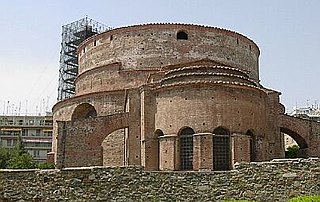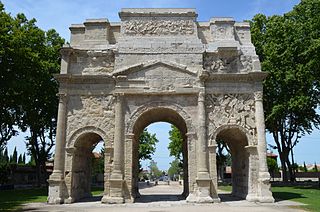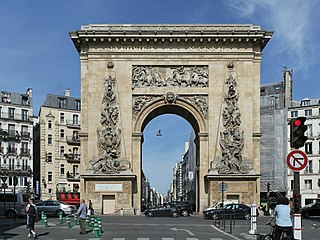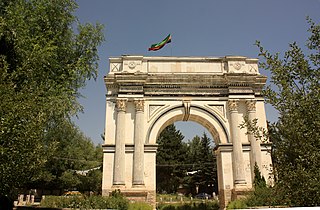Arch of Triumph may refer to:
- Triumphal arch, a monumental structure in the shape of an arch
Arch of Triumph may refer to:

The Arc de Triomphe de l'Étoile, often called simply the Arc de Triomphe, is one of the most famous monuments in Paris, France, standing at the western end of the Champs-Élysées at the centre of Place Charles de Gaulle, formerly named Place de l'Étoile—the étoile or "star" of the juncture formed by its twelve radiating avenues. The location of the arc and the plaza is shared between three arrondissements, 16th, 17th (north), and 8th (east). The Arc de Triomphe honours those who fought and died for France in the French Revolutionary and Napoleonic Wars, with the names of all French victories and generals inscribed on its inner and outer surfaces. Beneath its vault lies the Tomb of the Unknown Soldier from World War I.

The Arch of Titus is a 1st-century CE honorific arch, located on the Via Sacra, Rome, just to the south-east of the Roman Forum. It was constructed in c. 81 CE by Emperor Domitian shortly after the death of his older brother Titus to commemorate Titus's official deification or consecratio and the victory of Titus together with their father, Vespasian, over the Jewish rebellion in Judaea.

The Arch of Galerius or Kamara (Καμάρα) and the Rotunda (Ροτόντα) are neighbouring early 4th-century AD monuments in the city of Thessaloniki, in the region of Central Macedonia in northern Greece. As an outstanding example of early Byzantine art and architecture, in addition to the importance of the Rotunda as one of the earliest Christian monuments in the Eastern Roman Empire, both sites were inscribed on the UNESCO World Heritage List in 1988 as part of the Paleochristian and Byzantine monuments of Thessaloniki.

A quadriga is a car or chariot drawn by four horses abreast and favoured for chariot racing in classical antiquity and the Roman Empire. The word derives from the Latin quadrigae, a contraction of quadriiugae, from quadri-: four, and iugum: yoke. In Latin the word quadrigae is almost always used in the plural and usually refers to the team of four horses rather than the chariot they pull. In Greek, a four-horse chariot was known as τέθριππον téthrippon.

A triumphal arch is a free-standing monumental structure in the shape of an archway with one or more arched passageways, often designed to span a road, and usually standing alone, unconnected to other buildings. In its simplest form, a triumphal arch consists of two massive piers connected by an arch, typically crowned with a flat entablature or attic on which a statue might be mounted or which bears commemorative inscriptions. The main structure is often decorated with carvings, sculpted reliefs, and dedications. More elaborate triumphal arches may have multiple archways, or in a tetrapylon, passages leading in four directions.

The Arc de Triomphe du Carrousel is a triumphal arch in Paris, located in the Place du Carrousel. It is an example of Neoclassical architecture in the Corinthian order. It was built between 1806 and 1808 to commemorate Napoleon's military victories in the Wars of the Third and Fourth Coalitions. The Arc de Triomphe de l'Étoile, at the far end of the Champs-Élysées, is about twice the size; designed in the same year but not completed until 1836.

The Narva Triumphal Arch was erected in the vast Stachek Square, Saint Petersburg, in 1814 to commemorate the Russian victory over Napoleon.
A triumphal entry is a ceremonial entry by a person, often into a city.

The Arch of Triumph is a triumphal arch in Pyongyang, North Korea. It was built to commemorate the Korean resistance to Japan from 1925 to 1945. It is the second tallest memorial arch in the world, after Monumento a la Revolución in Mexico, standing 60 m (197 ft) high and 50 m (164 ft) wide.

Arch of Triumph is a 1984 British television film by HTV. It is based on the novel Arch of Triumph by Erich Maria Remarque, author of All Quiet on the Western Front. The novel was previously adapted in 1948 for a film of the same name with Ingrid Bergman and Charles Boyer. It was released on 19 December 1984 in the UK, and on 29 May 1985 in the US.

The Schwerbelastungskörper is a large concrete cylinder located at the intersection of Dudenstraße, General-Pape-Straße, and Loewenhardtdamm in the northwestern part of the borough of Tempelhof in Berlin, Germany. It was built by Adolf Hitler's chief architect Albert Speer to determine the feasibility of constructing large buildings on the area's marshy, sandy ground. Erected between 1941 and 1942 it was meant to test the ground for a massive triumphal arch on a nearby plot. The arch, in the style of the Nazi architectural movement, was to be about three times as large as the Arc de Triomphe in Paris, France. It was one component of a plan to redesign the center of Berlin as an imposing, monumental capital reflecting the spirit of Nazi Germany as envisioned by Hitler.

Arch of Triumph is a 1948 American romantic war drama film directed by Lewis Milestone and starring Ingrid Bergman, Charles Boyer, and Charles Laughton. It is based on the 1945 novel Arch of Triumph by Erich Maria Remarque, which he wrote during his nine-year exile in the United States.

The Triumphal Arch of Orange is a triumphal arch located in the town of Orange, southeast France. There is debate about when the arch was built, but current research that accepts the inscription as evidence favours a date during the reign of emperor Augustus. It was built on the former via Agrippa to honor the veterans of the Gallic Wars and Legio II Augusta. It was later reconstructed by emperor Tiberius to celebrate the victories of deceased general Germanicus over the German tribes in Rhineland. The arch contains an inscription dedicated to emperor Tiberius in AD 27. Along with the Roman Theatre of Orange, the Triumphal Arch was inscribed on the UNESCO World Heritage List in 1981 because of its exceptional preservation.

A tetrapylon is a rectangular form of monument with arched passages in two directions, at right angles, generally built on a crossroads. They appear in ancient Roman architecture, usually as a form of the Roman triumphal arch at significant crossroads or geographical "focal points".

Porte d'Aix is a triumphal arch in Marseille, in the south of France, marking the old entry point to the city on the road from Aix-en-Provence. The classical design by Michel-Robert Penchaud was inspired by the triumphal arches of the Roman Empire. The Porte d’Aix was initially conceived in 1784 to honour Louis XVI and to commemorate the Peace of Paris (1783) that ended the American Revolutionary War. Following the restoration of the Bourbon monarchy in 1814–15, the project was resumed in 1823, now to commemorate French victories in the Spanish Expedition, notably at the Battle of Trocadero, August 31, 1823. It was eventually completed in 1839, with a more general theme of victory.

The Porte Saint-Denis is a Parisian monument located in the 10th arrondissement, at the site of one of the gates of the Wall of Charles V, one of Paris' former city walls. It is located at the crossing of the Rue Saint-Denis continued by the Rue du Faubourg Saint-Denis, with the Boulevard de Bonne-Nouvelle and the Boulevard Saint-Denis.

The Triumphal Arch is a 16th-century monumental woodcut print commissioned by the Holy Roman Emperor Maximilian I. The composite image was printed on 36 large sheets of paper from 195 separate wood blocks. At 295 × 357 centimetres, it is one of the largest prints ever produced and was intended to be pasted to walls in city halls or the palaces of princes. It is a part of a series of three huge prints created for Maximilian, the others being a Triumphal Procession which is led by a Large Triumphal Carriage ; only the Arch was completed in Maximilian's lifetime and distributed as propaganda, as he intended. Together, this series has been described by art historian Hyatt Mayor as "Maximilian's program of paper grandeur". They stand alongside two published biographical allegories in verse, the Theuerdank and Weisskunig, heavily illustrated with woodcuts.

Porta Sempione is a city gate of Milan, Italy. The name is used both to refer to the gate proper and to the surrounding district (quartiere), a part of the Zone 1 division, including the major avenue of Corso Sempione. The gate is marked by a landmark triumphal arch called Arco della Pace, dating back to the 19th century, although its origins can be traced back to a gate of the Roman walls of Milan.
Principal Monuments of France is a series of four paintings created by the French artist Hubert Robert in 1786. They depict the ruins of several Roman structures in Provence.

The Taq-e Zafar is a memorial arch located at the front of the gardens in Paghman, Afghanistan. The famous victory arch commemorates Afghan independence after the Third Anglo-Afghan War in 1919.